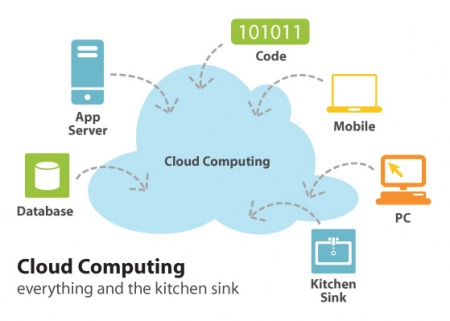Cloud Computing
From Computing and Software Wiki
Cloud Computing is a style of distributed computing where clusters of networked computers work together in a grid to perform massive tasks. They often provide services for end users in a dynamically scalable and seamless fashion.[3] They allow organizations to avoid costly capital expenditures of software and hardware while providing the benefits of both. The development of cloud computing has been compared to the development of the electricity network a century ago, where companies stop producing their own power and instead harness the power of a massive grid.[5]
Contents |
Services
Cloud computing offers the services of large infrastructure to the variable needs of end users. It allows individuals and organizations to connect to a "cloud" of computing resources to fuel their informational needs.It satisfies the need to increase capacity or add capabilities on the fly without investing in new infrastructure, training new personnel, or licensing new software.[2] There are two main categories of service.
Software as a Service (SaaS)
Software as a service is where computer applications are accessed directly over the Internet, rather than being installed on local desktops or data centre servers. SaaS allows network access to commercially available software. It delivers a single application through the browser to thousands of users using a multitenant architecture.[2] It allows clients the freedom to avoid investment in servers and software licensing and grants providers low-maintenance costs since only a single application must be managed.
Hardware as a Service (HaaS)
Hardware as a service is where computer processing capacity is purchased over the web. It is the delivery of computer infrastructure as a service. It allows clients to forego purchasing servers, software, space, and equipment and instead purchase it as a fully outsourced service. Costs are generally reflected with the amount of usage. It is characterized as being elastic, flexible, inexpensive, and reliable. This is because demands for computing power can be dynamically scalable with the reliability associated with large infrastructures.[7]
Tradeoffs
As with any organizational decision there are tradeoffs that must be considered when adopting a new technology, even with one as convenient and useful as cloud computing.
Advantages
As stated above, cloud computing offers organizations to forego costly capital expenditures of hardware and software. All of the costs associated infrastructure such as space, electricity, maintenance, and security can be offloaded into a singular operational expense.[1] This significantly reduces barriers of entry into the large-scale computing space.[3] The "pay-as-you-go" model of cloud computing services means that organizations only have to pay for as much as they use. This can mean significant savings in the long run. The ability to add these services "on-the-fly" even further enhances an organizations adaptability to rapidly changing demands from their clientele/users.
Disadvantages
No new technology comes without its disadvantages. With cloud computing companies put their data and applications in the hands of others. As one can imagine, this is a significant risk that must be considered. Thus organizations that invest in such services must be able to trust that their intellectual property is handled in a secure manner. No matter how secure a cloud solution may be, mission-critical data and applications should generally be kept within the organization. Organizations and individuals considering cloud solutions should research carefully and determine the control the provider and the client have over data, and how data encryption and recovery is carried out.[1]
Companies Offering Cloud Computing Services
Software As A Service
There are many companies that offer SaaS. Individuals and organizations can use Google's infrastructure to run their office applications such as Gmail and Google Docs. Other commercial software include project management tools from Clarizen as well as customer relationship management software from Salesforce and Zoho.[1] These online applications remove significant burden from IT departments by being easily deployed and managed. It also frees their users from being tethered to a singular machine, as all they need is to be connected to the internet to access the cloud. As an example, the Telegraph Media Group successfully migrated 1,400 of its employees to Google Apps. They found services to be superior to their previous software package, as connecting to the cloud eased collaboration and communication. It is estimated that over the next three years the organization will reduce software costs by 80%.[6]
Hardware As A Service
Amazon offers a web service called Elastic Compute Cloud or EC2. This allows users to purchase computer processing power online from Amazon, and on the basis on the processor cores, storage and data transfer they require in each "instance".[1] Machines are virtualized, and each functions as virtual private server with variable system specifications. Costs are incurred by usage in terms of hours per virtual machine, and the amount of data transferred. It uses a simple web service interface to obtain and configure capacity with minimal friction.
GoGrid is another cloud infrastructure service provider, hosting Linux and Windows virtual machines managed by a web-based server control panel. Similar to Amazon's EC2 service, they offer solutions on a cloud that are scalable, reliable, affordable, and easy to use.
References
- Cloud Computing: An Introduction
- What Cloud Computing Really Means
- History of Cloud Computing
- Cloud Computing: Everything and the Kitchen Sink
- Explaining Cloud Computing
- Telegraph spreads the news on Google Apps
- HaaS
See Also
External Links
- Wikipedia's entry on Cloud Computing
- Cloud Computing in Plain English
- What Cloud Computing Really Means
- Google AppEngine
- Salesforce.com Enterprise Cloud Computing
- Web 2.0 and Cloud Computing
--Kimm23 20:24, 12 April 2009 (EDT)


